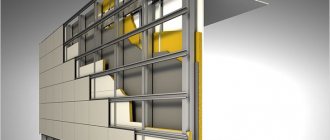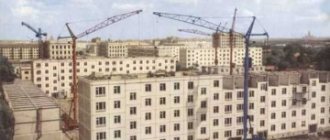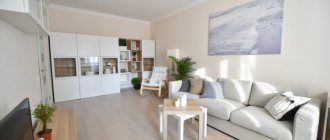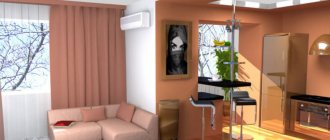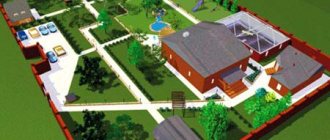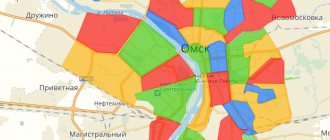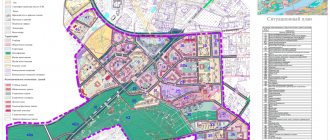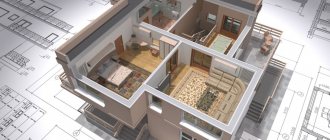The majority of multi-storey buildings in modern Russia are panel buildings.
With the help of this real estate model, the country coped with the accelerated implementation of the urbanization program. Each resident was to get a new apartment.
Panel houses of yesterday and today are complete opposites. If previously a panel house looked like a gray, unsightly building, today, thanks to modern construction technologies, such houses sometimes look like works of art.
But the technology of panel construction has remained the same. How does this type of construction compare favorably with other real estate? We'll talk about this and much more in this article.
What is a panel house?
Among standard residential buildings, panel houses have become very popular. They were identical not only to their reinforced concrete “neighbors,” but also to standard buildings in other Russian cities.
Panel house
- this is a structure built according to the Lego principle from prefabricated reinforced concrete slabs (panels) manufactured at the factory. Block sections, practically a disassembled house, are delivered to the construction site. All that remains is to collect it.
The finished reinforced concrete panel resembles a sandwich in its structure: an outer facing layer, reinforced concrete, insulation and reinforced concrete again. The insulation consists of expanded polystyrene or rigid mineral wool. These layers are connected by a reinforced concrete flexible connection - a reinforcement cage is laid into the insulation, thereby tightly fastening the layers without gaps. The front side of the panel can be smooth, embossed, or lined with decorative facing slabs.
The panels are manufactured at specialized enterprises, then delivered to the site of the future home on panel trucks. The duration of assembly of a multi-storey panel house depends on the number of floors, but almost always lasts no more than a year.
There are frame-panel buildings and frameless (large-panel houses). The first type includes a frame made of columns, interpanel floors and walls. The frame type of construction is primarily suitable for low-rise construction. In frameless houses, longitudinal load-bearing walls rest on transverse load-bearing walls.
A special feature of the typical development of panel houses is affordable housing in the shortest possible time. The technology of panel housing construction still solves the housing problem. The demand for affordable housing is high, and thanks to developers, the choice of budget housing is becoming wider and more colorful, literally and figuratively.
Construction of frame-panel houses - classic technology and quick assembly
Frame-panel or frame-panel houses are assembled from elements prepared at the factory. Finished walls are made using high-precision equipment. Construction companies offer standard house kits or customized custom designs.
Basic principles of frame technology
Frame houses are popular due to short construction times and cost-effectiveness. Using this technology, a frame is first made of beams and boards, then insulation, membrane layers that protect from moisture and wind, and a vapor barrier are installed. The structure is sheathed on both sides with sheet materials, and then the external and internal cladding is made with finishing materials.
In a traditional frame house, all the “layers” of the wall are assembled on site according to a pre-developed design. Sometimes they talk about prefabricated frame houses, meaning ready-made house kits in which wooden elements and panels are prepared in production to the dimensions of a specific project and marked. At a construction site, they are assembled like a construction kit according to drawings.
Design and production of house kits for frame-panel houses
Manufacturing is automated: window and door openings and even holes for sockets are cut in advance. But the degree of automation of production at different enterprises differs.
The most advanced automation option - design drawings are loaded into a computer, the location of technological openings and places for stitching frame elements are specified. The output is ready-to-assemble elements with virtually no manual processing.
House kits are made according to standard samples; minor changes in the layout are possible, but must be made before launching into production. Calculation and production of an individual project is much more expensive than a standard one, and the equipment has to be rebuilt. The finished walls are brought directly to the site and the house is assembled, and the exterior and interior decoration is done by hand.
Advantages and disadvantages of frame-panel houses
Advantages:
- faster assembly compared to standard frame technology;
- no shrinkage, the ability to immediately begin finishing;
- the use of a lightweight foundation and, as a result, budget savings;
- energy efficiency comparable to a brick house;
- fire safety due to the use of self-extinguishing materials for the production of panels.
Flaws:
- increase in cost compared to a standard frame;
- service life - 50-60 years;
- impossibility of making changes during the construction process;
- the need to install fresh air ventilation, although some manufacturers claim that simple ventilation is sufficient for summer houses;
- difficulty in redevelopment after some time.
Typical buildings of the past
Standard construction in Russia began under Peter I in St. Petersburg. Clay houses were built literally from scrap materials, by analogy with village huts. Such housing was very economical and safe, since clay was resistant to fire.
At the beginning of the 20th century, when times of coups d'etat began in Russia, in France the architect Le Corbusier developed a project called “Domino” for the development of Paris with prefabricated standard houses. The project was not realized, but it became the starting point of a new modernist branch in architecture - brutalism. The main feature of the style was the finishing of buildings with raw concrete. Vivid examples of brutalism can be considered monuments to communism in Bulgaria and the countries of the former Yugoslavia.
Mount Buzludzha in Bulgaria, house-monument to communism
In 1920, Corbusier visited Moscow and met the main Soviet constructivists Konstantin Melnikov, Moses Ginzburg and the Vesnin brothers. Inspired by the ideas of the French architect, they built more than two hundred objects in the capital, one of which to this day is the building of the Moscow Central Union. Thus began the era of “dull boxes,” which are often called panel houses.
The building of the Moscow Central Union
Modern “sockets”: bright facades, varied layouts, relatively low prices
The editors of the portal “Real Estate Market Indicators IRN.RU” are launching a series of articles about construction materials. We will tell you what modern high-rise buildings are made of and how different construction technologies affect the price of apartments in buildings and the comfort of life in them. Let's start with the panel.
Since the Soviet era, panel houses have been criticized for their unsightly appearance, poor sound insulation, low ceilings, inconvenient layout and lack of individuality. The first industrial series were designed to quickly and, most importantly, cheaply solve the housing problem, which is why we had to abandon any planning and architectural excesses.
Modern panel houses cannot be compared with the gray “boxes” of yesteryear: the quality of installation has become higher, sound insulation is better, facades are brighter, layouts are more varied. But the main feature of this type of construction remains the same - it allows you to build quickly.
Typical doesn't mean bad
Panel houses are built according to the Lego principle from prefabricated reinforced concrete slabs - factory-made panels that are delivered ready-made to construction sites. You can build such a house in less than a year. This is an important advantage for those who want to quickly move into a new apartment.
Today there are several main manufacturing plants for kits for large-panel housing construction - PIK-Industry, House-Building Plant No. 1 (DSK-1), Glavmosstroy, lists the head of architectural workshop No. 4 of the Urban Planning Institute for Spatial Modeling of Cities "Giprogorproekt" Anton Bavykin .
In recent years, panel series of houses have been greatly modernized, notes Andrei Zimonov, construction director of the Granel Group of Companies. First of all, he said, various indicators have improved in accordance with the new norms. These include taking into account increased fire safety requirements and energy and heat conservation. In addition, the consumer qualities of such housing have improved.
“The planning solutions have improved: the possibilities for interior planning have seriously expanded, the kitchen area has increased to 16-18 square meters. m, bay windows and dark rooms appeared, the ceilings became higher. One of the factories has modernized its production line and produces floor slabs 9 m long, although standard structures are 6 m long. This provides ample opportunities for various apartment design options. The architectural appearance has also been updated, and engineering systems have kept pace with the demands of the times,” the expert lists.
For example, DSK-1 builds houses using a three-layer exterior panel with ceramic tile cladding and ready-made glazing. “This “three-layer” system, consisting of reinforced concrete, insulation and decorative cladding, retains heat well and ensures silence,” says Grigory Altukhov, commercial director of First DSK. And the use of a single-layer panel with the subsequent installation of ventilated facade systems allows DSK-1 to build houses of almost any visual appearance.
In addition, according to Andrei Zimonov, today new series of panel houses are designed in accordance with the principles of a barrier-free environment. And the average service life of the new panel series has doubled - up to 100 years (versus 50 years for the “panels” of the 80s).
Among the “advantages” of panel high-rise buildings, Nadezhda Korkka, managing director (participant of the CBRE partner network), names the fact that they, as a rule, give a uniform settlement. This allows you to begin finishing work almost immediately - both internal and facade. Openings in panel houses are always standard, which makes it easier for new residents to choose ready-made doors and windows and provides savings (there is no need to order atypical models).
There are some disadvantages
Among the disadvantages that determine the lower price of housing in a panel house, Nadezhka Korkka names a lower quality level of sound insulation and a lower ability to accumulate heat compared to monolithic and brick houses. Poor quality sealing of interpanel seams is also possible (this leads to increased humidity).
“Sound insulation in panel houses is inferior to monolithic projects,” agrees Sergei Kovrov, head of the consulting and analytics department at NDV-Supermarket Real Estate. — This is especially true in panel houses of older series. In P44 houses there is a high chance of hearing neighbors from all sides and being woken up every night by the crying of a baby two floors below.”
Another nuance is that it is impossible to do a complete redevelopment in a panel house, since load-bearing walls between rooms cannot be demolished, adds commercial director of DSK-1 Grigory Altukhov.
Nevertheless, the demand for panel houses is great, experts admit. Today on the market we can roughly distinguish two types of panels - standard (P-44, P-44T, KOPE) and improved (DOMMOS, EuroPa, PIK-1, PIK-2, etc.).
Popular standard series: P-44T, P-3M and KOPE
The leaders in demand, according to Metrium, are houses of the P-44T and KOPE series.
P-44T series
“The most popular panel series today is definitely the P-44T, a modification of the P-44 series,” agrees the head of the analytical department, Dmitry Taganov. — These are, as a rule, 12-, 14-, 17-story buildings. A distinctive feature of the series is the “brick-like” cladding of the external walls and the white stripes that highlight the balconies.”
Since 1997, a series of P-44T houses have been built both in new areas of mass development in Moscow and in old areas as part of the program for demolition of five-story buildings (Yuzhnoye Chertanovo, Zyuzino, Cheryomushki, etc.).
“The P44T series is perceived easily and positively,” says Valery Letenkov, General Director of the Real Estate Investment Agency. — These objects outperform competitors because of their pleasant appearance. The layout of common areas is logically correct. In addition, on the ground floor of such houses there is a place for a concierge, which is also a big plus for buyers.”
In the houses of the P-44T series, all apartments have separate bathrooms, the expert continues, the rooms are isolated. The average area of a one-room apartment is about 40 square meters. m. All apartments have a balcony, and some three-room apartments have two.
True, according to Dmitry Taganov from Inkom, in P-44T houses there is also a parallel layout of two-room apartments - there the corridor area is reduced to such an extent that it is impossible to install even a built-in wardrobe in it. The disadvantages of the P-44T are standard for standard series - not very good sound insulation.
KOPE series
Another popular series is KOPE. Built in Moscow since 1982. But since the 1990s, entire new areas began to be built up with houses of this series, recalls Dmitry Taganov. For example, a lot of such housing was rented out in Altufyevo, on Timiryazevskaya, in Maryino.
“At one time, this series was distinguished by relatively large kitchens - from 10 square meters. m, now such footage, of course, is no longer impressive. But thanks to the limited number of load-bearing walls in three-, four- and six-room apartments, it is quite easy to remodel. The disadvantages include a tiny corridor in a one-room apartment. At one time there were many complaints that KOPE houses began to be rented out without sealing the interpanel seams, and this “improvement” went to the residents,” the expert shares.
P-3M series
Construction Director of the Granel Group of Companies Andrey Zimonov recommends paying attention to the houses of the P-3M series, the planning solutions of which meet most of the requirements set by buyers. They consist of straight and corner sections, each with four apartments on each floor. All three-room apartments in this series are “vest” - their windows face opposite sides of the house. Four-room apartments have two bathrooms. Three- and four-room apartments are decorated with bay windows. The consumer characteristics of housing in this series are improved by loggias and “dark” rooms.
The peak of construction of houses of the P-3M series in Moscow occurred in the late nineties - early 2000s. These are multi-section panel houses with a height of 8 to 17 floors. The first floors in the houses of this series could be either residential or allocated for infrastructure facilities.
However, an obvious design flaw in the series, notes Dmitry Taganov from Inkom, is the very small living space in a one-room apartment (14.3 sq. m) and the absence of a balcony in one of the types of one-room apartments.
Bekeron series
Since 1994, houses of this series began to be built by an enterprise of the same name, which previously specialized in the construction of social facilities. The Bekeron series are panel houses with a height of no more than 7 floors, which are not widely used. In total, about 30 houses were built according to the Bekeron project in Maryino, Novokosino, Yuzhny Butovo and several other districts of Moscow and the region.
“The houses of the Bekeron series, the construction volumes of which are relatively small, are interesting in consumer and urban planning relations,” Andrey Zimonov points out. — They have a low number of floors - a maximum of 7 floors, standing out against the background of tall standard panels. Compared to them, the areas of apartments in the Bekeron series are increased. One-room apartments have an area of more than 55 square meters. m, for two-room apartments - about 70 square meters. m, for three rubles – more than 85 sq. m, the area of four-room apartments exceeds 100 sq. m. m. High ceilings (about 3 m), wide rooms due to the 6-meter span of load-bearing walls and the presence of two windows in one of the rooms create great opportunities for the buyer to create an original design solution for their apartment.”
Improved “sockets”: DOMMOS, SEM-1, SEM-2 and “Sobyaninki”
Today on the primary market you can find improved series of panel houses (DOMMOS, SEM-1, SEM-2, etc.), notes Nadezhda Korkka from Metrium. The construction of panel houses of old series in Moscow has been stopped since 2021 by order of Mayor Sergei Sobyanin.
DOMMOS Series
DOMMOS is a series of houses from 6 to 25 floors, presented in 2015. The series is distinguished by the variability of layouts, which is possible thanks to the increased pitch of internal load-bearing walls - up to 6.6 m. There are several options for studios alone, starting with tiny 12 “square” and ending with a spacious area of 34 sq. m.
In addition to studios, the houses of the DOMMOS series provide 1-, 2-, 3- and 4-room apartments with the possibility of combining. Each apartment, according to Nadezhda Korkki, in addition to balconies and loggias, has a French balcony.
Series "SEM-2"
Houses of the SEM-2 series and its modifications have been built since 2021. These are multi-section houses with a height of 15 to 33 floors. The ceiling height in the apartments is from 2.65 to 2.9 m. There are from 4 to 12 apartments on the site, depending on the layout of the house. And the number of possible layouts for the apartments themselves reaches fifty.
Houses of the SEM-2 series are built in “standard” and “comfort” class projects. The main difference of the series is underground parking. In addition, there are storage rooms in the basements.
“SEM-2” are multi-storey residential buildings built according to the project of the PIK Group of Companies, says Nadezhda Korkka. The peculiarity of the series is that the utility risers in the apartments are located against the wall adjacent to the inter-apartment corridor. This opens up access to communications and meters from the corridor, and management company employees can carry out the necessary procedures even in the absence of the owners. In addition, this solution provides flexibility in the implementation of various interior ideas.
Series "Europa"
Experts also name the “Europa” series from ZhBI-6, 17-25 floors high, among the successful series for living, which benefits from layout, structural strength, a small number of load-bearing walls (this gives many opportunities for redevelopment), and good sound insulation. Among the features of this series: spacious loggias in all apartments, large living rooms and kitchens.
So, the studio area, for example, is 25-28 square meters. m, "odnushki" - 33-41 sq. m, two-room apartments - 52-104 sq. m. There are also 3- and 4-room apartments. The minimum kitchen area is 10-11 square meters. m. Except for studio apartments. Here the kitchen niche occupies 5-6 square meters. m. Some apartments have dark rooms (closets).
For example, houses of the “Europe” series with apartments of various sizes and layouts can be found in the comfort-class residential complex “Luchi” in Solntsevo.
"Renovation" series
In recent years, Moscow has also launched the construction of houses of new “renovation” series - PM-P and PM-SH, which have already been nicknamed “Sobyaninkas”. They were developed in 2012 to resettle citizens from dilapidated housing and houses from the Khrushchev period. Apartments in Sobyaninka apartments are larger than in the old socket buildings, mainly due to more spacious kitchens and corridors.
Exclusive series from developers
In addition, developers themselves are developing new series of panel houses for their projects. For example, for the residential complex "Gosudarev's House" (Moscow region, Leninsky urban district), the Granel Group of Companies, together with Lime Construction, has developed a new series of modern standard houses, which are produced at modernized house-building factories for reinforced concrete products in Sergiev Posad and Mozhaisk. These are the Optima S and Lime series. In particular, in the buildings of the Optima S series (GVSU "Center") a new “dry” structural unit for connecting external and internal wall panels is used, which completely eliminates the possibility of leaks and freezing of external walls.
Panel outsiders
The list of outsiders mainly includes the very first series of panel houses, which, of course, today are already presented only on the secondary market.
According to Nadezhda Korkki from Metrium, the Khrushchev series 1-507 and 1-335 top the list of outsiders in the secondary housing market.
Houses of the 1-335 series were built throughout the former USSR from 1956 to 1968. About 70 houses have been built in Moscow, mainly in the areas of Perovo, Sokolinaya Gora, Babushkinsky, Degunino, and Kuntsevo. These are, as a rule, five-story houses with windows on the landings that are elongated to almost the entire panel. The houses have 1-, 2- and 3-room apartments with combined bathrooms and 2.55 m ceilings. The central room in all three rubles is a walk-through room.
Series 1-507 were built from 1958 to 1972. These are houses of 5 or 7 floors. The ceiling height in the apartments is 2.5 m. There are balconies on all floors except the first.
“In such houses there is no elevator or garbage chute, and there is no attic. The apartment layouts are distinguished by a modest area of rooms and kitchens, the presence of adjacent rooms, and low ceiling heights. “Brezhnevki” are a more popular product, but they also cannot be called popular. In any case, this is obsolete and illiquid housing,” the expert lists.
Valery Letenkov from the Real Estate Investment Agency names series 2–18/9 houses as unsuitable for living. These are nine-story, single-entrance tower-type houses. In Moscow, such houses are dispersed in areas of mass residential development of the 60s: Cheryomushki, Tekstilshchiki, Kuzminki, Izmailovo, etc. The houses have 1- and 2-room apartments with combined bathrooms and sitz baths, eight apartments per floor. The ceiling height is 2.5 m. The houses have one passenger elevator and a garbage chute.
Among the disadvantages of this series, Valery Letenkov names the small area of the rooms (30 sq. m. for a one-room apartment and 44 sq. m. for a two-room apartment) and kitchens (only 5.5 sq. m.), low ceilings (2.5 m), combined bathrooms with sitting bathrooms.
Also, according to the expert, the 2-49 series is unsuccessful, which also provides small-area apartments: one-room apartments - from 31 square meters. m, two-room apartments – from 44 sq. m. Kitchen area - less than 6 square meters. m.
Series 2-49 are nine-story multi-section panel houses that “grew up” from 1965 to 1985, mainly in the areas of Teply Stan, Yasenevo, Belyaevo, Cheryomushki, Orekhovo, and Akademichesky. The houses are designed with apartments ranging from one-room apartments to five-room apartments with separate bathrooms. All apartments except one-room apartments have large loggias.
Valery Letenkov also does not recommend considering for purchase houses that were excluded from the renovation program at the request of residents: “The resource of these houses is almost exhausted.”
“Panels” that benefit everyone
From a financial point of view, the construction of panel houses is beneficial for both the developer and the buyer, Andrei Zimonov, construction director of the Granel Group of Companies, is sure: “For companies, this means the pace of construction, and for buyers, this means a shorter waiting time for the delivery of the house and savings on finishing. This is due to the fact that the panel itself is flat, and repairs are less expensive and require less building materials.”
Not only will renovations in the apartment be cheaper, but also its cost: if you don’t take the location into account, then yes, the panel is cheaper than brick and monolith, experts say. According to Bon Ton, in the comfort class of “old” Moscow, the average cost per square meter in a typical panel house with finishing is 10% lower than in a monolithic house with finishing (166.4 thousand rubles and 182.2 thousand rubles .).
As Sergei Kovrov, head of the consulting and analytics department at NDV-Supermarket Real Estate, clarified, today the average cost of sq. m. m in panel new buildings in Moscow is 168.8 thousand rubles, in New Moscow - 172.3 thousand rubles, in the Moscow region - 126.4 thousand rubles.
Sergey Kovrov explains the difference in the average cost of a panel in “old” Moscow and “new” Moscow by the difference in the volume of existing supply.
“In the first ten months of 2021, developers in the territory of old Moscow commissioned 155 residential buildings with a total area of 2.12 million square meters. m. 1.6 million sq. m. were commissioned in New Moscow. m of residential real estate, or 122 objects. By 2035, another 52 million square meters will be built in TiNAO. m of residential facilities. Through simple mathematical calculations, one can understand that the percentage of recently introduced panel houses relative to “Khrushchev” or “Stalin” buildings in New Moscow is many times higher than within the borders of “old” Moscow. Therefore, the excess of the average price in such houses is not at all surprising,” the expert concludes.
On the secondary market, prices for apartments will differ depending on the year of construction and the location of the house, notes Nadezhda Korkka from Mertrium. Apartments of the Khrushchev and Brezhnev series will cost much less if they are located on the outskirts of the city. The same series in the Moscow City location will cost much more than apartments in more “advanced” and modern series, but in non-prestigious residential areas. So, the average cost of a Moscow two-room apartment in a panel house. area 52 sq. m on the secondary market is 9 million rubles, while in the City area a similar apartment will cost at least 15 million rubles.
Where to buy: supply in Moscow is falling, but there is a choice in the region
Once popular panel houses are today losing their position in the Moscow primary housing market, experts admit. Today, panel houses prevail in the secondary market, where all series of panel houses are presented, starting from the moment of their appearance (1940s), there are more than 50 of them, says Managing Director Nadezhda Korkka.
But on the primary market within the boundaries of “old” Moscow today, only 10.7% of apartments (20 projects) are sold in houses of improved panel series (PIK, DOMRIK, DOMMOS, DOMNAD), another 2.1% (7 projects) - in standard . In New Moscow, 17.9% (4 projects) of the proposal refers to an improved panel, 0.3% (2 projects) to a standard panel.
Volume of panel construction in the primary market of Moscow
| № | Project name | Developer | Class | Room type | Constructive | Sales area, sq.m. | SVC, rub. |
| 1 | "Ilmensky 17" | PEAK | comfort | apartments | PIK3 | 20 496 | 210 286 |
| 2 | "Big Ochakovskaya 2" | PEAK | comfort | apartments | PIK2 | 17 191 | 232 141 |
| 3 | "Amur Park" | PEAK | comfort | apartments | PIK3 | 17 023 | 189 377 |
| 4 | "Lublin Park" | PEAK | comfort | apartments | PIK2 | 11 629 | 175 635 |
| 5 | "Rustaveli 14" | PEAK | comfort | apartments | PIK3 | 11 070 | 216 946 |
| 6 | "Signal 16" | PEAK | comfort | apartments | PIK3 | 10 993 | 205 940 |
| 7 | "Spacious 7" | PEAK | comfort | apartments | SAM | 9 621 | 236 006 |
| 8 | "Novokhokhlovskaya 15" | PEAK | comfort | apartments | PIK3 | 9 357 | 190 008 |
| 9 | "Second Nagatinsky" | PEAK | comfort | apartments | PIK3 | 9 221 | 222 104 |
| 10 | "Kronstadsky 14" | PEAK | comfort | apartments | PIK3 | 7 969 | 217 859 |
| 11 | "Perovskoe 2" | PEAK | comfort | apartments | PIK3 | 6 870 | 180 426 |
| 12 | "Kronstadsky 9" | PEAK | comfort | apartments | PIK3 | 6 624 | 229 081 |
| 13 | "Businovsky Park" | PEAK | comfort | apartments | PIK3 | 6 309 | 162 519 |
| 14 | "Yasenevaya 14" | PEAK | comfort | apartments | PIK2 | 5 820 | 223 708 |
| 15 | "Bolshaya Academicheskaya 85" | PEAK | comfort | apartments | PIK3 | 5 033 | 209 199 |
| 16 | "Krasnokazarmennaya, 15" | PEAK | comfort | apartments | PIK2 | 4 407 | 217 702 |
| 17 | "Mitinsky Park" | PEAK | comfort | apartments | PIK3 | 3 864 | 144 077 |
| 18 | "Molodogvardeyskaya 36" | PEAK | comfort | apartments | PIK2 | 2 784 | 264 242 |
| 19 | “My address is in Medvedkovo-2” | Mosrealstroy | standard | apartments | P-44 | 1 136 | 149 612 |
| 20 | “My address is in Beskudnikovo-3” | "Mosrealstroy" | standard | apartments | panel | 1 055 | 182 310 |
| 21 | “My address is on Shokalsky” | "Mosrealstroy" | standard | apartments | P-44/DOMMOS | 815 | 165 010 |
| 22 | “My address is on Dmitry Ulyanov” | "Mosrealstroy" | standard | apartments | I-155 | 543 | 219 117 |
| 23 | “My address is on Nagornaya” | "Mosrealstroy" | standard | apartments | P-44K | 339 | 184 077 |
| 24 | “My address is on Zarevoy” | "Mosrealstroy" | standard | apartments | DOMRIK | 222 | 168 651 |
| 25 | "Level 16" | "Altai" | standard | apartments | panel | 2 879 | 172 347 |
| 26 | "Aerovilla" | "Altai" | standard | apartments | panel | 441 | 192 060 |
| 27 | "Botanist" | "Altai" | standard | apartments | panel | 324 | 198 656 |
| 28 | "Nekrasovka" | "Avesta" | standard | apartments | P44T | 9 816 | 148 833 |
| 29 | "Striving for the Light" | Seven Suns Development | comfort | apartments | panel | 20 490 | 167 708 |
| 30 | "Myspace on Festivalnaya" | MySpace Development | standard | apartments | panel | 483 | 229 680 |
| 31 | "Myspace on Okskaya" | MySpace Development | standard | apartments | panel | 302 | 255 166 |
| 32 | "Green vertical" | “E.K. Development" | comfort | apartments | panel | 1 411 | 172 019 |
| 33 | "The World of Mitino" | "Development" | comfort | apartments | DOMMOS | 814 | 160 212 |
Source: Bon Ton
According to Metrium, panel houses are also presented in the comfort class residential complexes “Buninskie Meadows”, “Mikhailovsky Park”, “Myakinino Park” and “Polyarnaya 25” (the developer is the PIK group). The houses being built here belong to the PIK-1, PIK-2, SEM-2 and KOPE-M-Parus series.
Nadezhda Korkka from Metrium notes that two years ago the supply of panel housing on the primary market in Moscow was twice as high – 20% versus today’s 10%.
“The reason is not the lack of demand for panel houses, but the lack of free plots for the development of mass construction areas and their high cost. Therefore, standard series of houses within the Moscow Ring Road are in most cases built for various urban social programs (for example, for renovation). But in “old” Moscow beyond the Moscow Ring Road, New Moscow and in the Moscow region, the situation is different: approximately half of the housing being built is made up of panels,” the expert concludes.
All mentioned projects are on sale (June 2021)
TableMap
| Project | Location | GK | Price per apartment |
| Rays | Moscow, Western District, Solntsevo district, Solntsevo metro station | 4 sq. 2021 | from 9,034,529 rub. |
| Bunin meadows | New Moscow, Novomoskovsky District, Buninskaya Alley metro station | 3 sq. 2023 | from 4,886,000 rub. |
| Botanist | Moscow, North-Eastern district, Otradnoe district, Likhobory MCC metro station | — | |
| Perovskoe 2 | Moscow, South-Eastern district, Nizhny Novgorod district, Nizhegorodskaya MCC metro station | 4 sq. 2022 | from 5,738,550 rub. |
| Second Nagatinsky | Moscow, Southern District, Nagatino-Sadovniki district, Nagatinskaya metro station | 1 sq. 2023 | from 6,494,400 rub. |
| Novokhokhlovskaya 15 | Moscow, South-Eastern district, Nizhny Novgorod district | 2 sq. 2023 | from 6,054,904 rub. |
| Signalny 16 | Moscow, Northern District, Otradnoye district, Vladykino metro station | 4 sq. 2022 | from 6,054,000 rub. |
| Rustaveli 14 | Moscow, North-Eastern district, Butyrsky district, Butyrskaya metro station | 4 sq. 2023 | from 7,855,920 rub. |
| Businovsky Park | Moscow, Northern District, Western Degunino district, Khovrino metro station | 2 sq. 2023 | from 5,250,000 rub. |
| Bolshaya Academicheskaya 85 | Moscow, Northern District, Timiryazevsky district, Okruzhnaya MCC metro station | 2 sq. 2023 | from 6,054,440 rub. |
| Amur Park | Moscow, Eastern District, Golyanovo district, Cherkizovskaya metro station | 4 sq. 2022 | from 6,054,740 rub. |
| Bolshaya Ochakovskaya 2 | Moscow, Western District, Ochakovo-Matveevskoye district, metro station Michurinsky Prospekt | 4 sq. 2022 | from 6,798,470 rub. |
| Aerovilla | Moscow, Southern District, Orekhovo-Borisovo Northern district, Orekhovo metro station | — | |
| Level 16 | Moscow, South-Eastern district, Maryino district, Bratislavskaya metro station | — | |
| Altai | Moscow, North-Eastern district, Marfino district, Vladykino metro station | from 2,652,000 rub. | |
| Polar 25 | Moscow, North-Eastern district, South Medvedkovo district, Medvedkovo metro station | 2 sq. 2023 | from 5,653,590 rub. |
| Spacious 7 | Moscow, North-Eastern district, Bogorodskoye district, Preobrazhenskaya square metro station | 2 sq. 2022 | from 7,225,690 rub. |
| Ilmensky 17 | Moscow, Northern District, Western Degunino district, Seligerskaya metro station | 3 sq. 2022 | from 7,512,120 rub. |
| Molodogvardeyskaya 36 | Moscow, Western District, Kuntsevo district, Molodezhnaya metro station | 2 sq. 2021 | from 18,530,880 rub. |
| Lublin Park | Moscow, South-Eastern district, Lyublino district, Bratislavskaya metro station | 1 sq. 2023 | from 5,495,400 rub. |
| Myakinino Park | Moscow, Western District, Kuntsevo district, Strogino metro station | 3 sq. 2022 | from RUB 5,352,760 |
| Mikhailovsky Park | Moscow, South-Eastern district, Ryazansky district, Ryazansky Prospekt metro station | 4 sq. 2022 | from 6,574,880 rub. |
| World of Mitino | Moscow, North-Western district, Mitino district, Pyatnitskoe highway metro station | 3 sq. 2021 | from 4,900,000 rub. |
| Sovereign's House | Leninsky district | 1 sq. 2021 | from RUB 3,891,654 |
| MIBC Moscow-City Neva Towers | Moscow, Central District, Presnensky district, Vystavochnaya metro station | from 28,965,200 rub. | |
| Yasenevaya 14 | Moscow, Southern District, Orekhovo-Borisovo Yuzhnoye district, Domodedovskaya metro station | from 8,038,620 rub. | |
| Green vertical | Moscow, Southern District, Chertanovo Yuzhnoye district, Lesoparkovaya metro station | from 7,700,000 rub. |
Data source: Real estate database IRN.RU
show all
Types of residential buildings
Before we continue talking about “socket panels,” let’s look at the existing types of residential buildings. Over the entire period of the existence of standard buildings, houses of various series have been designed and built. Some of them have official names, while the rest have “folk” nicknames. However, each of these types has its own unique characteristic.
- Block house.
The residential building in this series is assembled from concrete blocks.
The difference between a block house and a panel house is that the former is assembled from identical blocks (similar to huge bricks), while the panel house is made from shaped panels. This property of the block structure allows for redevelopment, destroying interior ceilings and combining rooms. The downsides are the poor quality of the plaster and uneven ceilings. The official episode code is ||-18
. - "Stalinka".
Elite type of residential buildings. Comfortable spacious apartments, high ceilings, convenient access. Typically located in the city center. The leading building material is brick or cinder blocks. The construction of “Stalin” buildings was completed in 1956, giving way to budget “Khrushchev” buildings.
- "Khrushchevka".
Ordinary five-story residential buildings that were built during the reign of Nikita Sergeevich Khrushchev from 1956 to 1964. Features of the "Khrushchev" - a small kitchen (6 m2), 2.5 m ceilings and a combined bathroom. There were no elevators or garbage chutes in such houses. Khrushchev buildings were built very quickly, which affected the quality of materials, and mainly near metro stations. One of the disadvantages of this type of building is poor thermal insulation. - "Brezhnevka".
The name came from the General Secretary of the CPSU Central Committee Leonid Ilyich Brezhnev.
The construction of such houses lasted from 1965 to 1980. In fact, this is a “Khrushchev” building brought to mind and comfort: the ceiling height is 2.65 m, the presence of a garbage chute and an elevator. The number of floors has also risen. Series of residential buildings 1605AM, I-209, P-42
.
- Individual types of residential buildings.
Today one of the most popular types.
Brick multi-storey buildings, the shape and improvement of which are not limited by any boundaries. The cost of an apartment in such a building is high, but it includes, among other amenities, the close location of ecological areas: park areas, rivers. Series of residential buildings P-44K
. - Monolithic type.
A unique feature of monolithic construction is the absence of seams on the walls. Such houses are made of concrete. Formwork is made right at the construction site and filled with concrete, giving the future building various architectural forms. It is often said about monolithic buildings that the walls in such houses do not “breathe”, but the concept of “breathing” of walls is nothing more than a folk stereotype. - Brick-monolithic type.
The frame of such houses is built from monolithic reinforced concrete, and the external walls are lined with bricks. Such houses are resistant to seismic activity and floods. Good sound and heat insulation. - Brick house.
High quality and corresponding price. Multi-apartment brick buildings are premium housing. The construction of one such multi-storey dwelling (up to 18 floors) takes more than two years. - Panel houses.
“Panels” are divided into three categories:- “137 series” with spacious kitchens (9 m2) and apartment area up to 70 m2.
- “Panels of the six hundredth series” are a middle class of quality and convenience. The area of the apartment is no more than 65 m2, the kitchen is of medium size.
- “504 series” is the cheapest option for panel housing construction. People call them “ships”. Small kitchen (up to 6.3 m2), no window sills.
Monolithic houses of portal participants
alexxxxx
made of monolithic reinforced concrete using removable formwork technology.
alexxxxx
The walls were minimally reinforced (openings, corners and upper layers of floors along the perimeter, trimmings between layers). The concrete was mixed ourselves, proportions 1/2.5/3 (cement, sand, crushed stone). Crushed stone used fractions of 20-40 mm, I regretted a thousand times that I did not buy 10-20 mm, it is difficult to take large ones with a shovel from a pile and it is much easier to bayonet concrete with a small fraction. It took two months with breaks for the main work (the slab was poured last year).
A house for permanent residence, the foundation is a regular slab, 15 cm thick, with ribs of 40 cm, backfilled with 30 cm sand, drainage around the perimeter. The slab was immediately filled with a heated floor contour, six branches (33 m each), water distribution to the bathroom and kitchen, and a sewerage system (grey drains).
The user's walls are 15 cm thick on the first floor and 12 cm on the second, lightweight floor slab (beams 15 cm, canvas 7-8 cm). It was not possible to finish it in one season, so the cast box spent the winter without a roof or insulation, but no cracks or other damage were found in the spring. In the new season, the project underwent changes, and the house acquired an extension using the same technology, but with the addition of a ready-made crushed stone-sand mixture to the concrete. Insulation with expanded polystyrene slabs on the facade (18-20 cm), expanded polystyrene crumbs on the attic floor (30-35 cm).
Our other craftsman is cprivetom
, preferred with PPS as insulation for his one-story monolithic house.
cprivetom
We began construction of a house for a family of six - two parents and four children, a house for permanent residence. I had to tinker with the layout. We treat the house quite utilitarianly, the main thing is that you can live in it comfortably, and decorativeness is secondary. Therefore, the form is simple - without bay windows, tricky corners, ledges and turrets, the roof is gable, the facades are without decorations. Some say you have a “barn” style, but for us it’s a simple “ranch”.
The foundation is a slab, 30 cm thick, lying on a 10 cm layer of EPS, the slabs are laid on a compacted bed of crushed stone (5 cm), the crushed stone is laid on a compacted sand “cushion” (40 cm). The main communications – water supply and sewerage – were previously laid out in a layer of sand. The insulation was covered with glass insulation, a reinforcement frame was laid in two layers with reinforcement under the load-bearing walls (125 mm pitch), and concrete was concreted with a ready-made solution.
Recently, developers are increasingly giving preference to concrete as a material for building houses. This is not surprising, since concrete buildings are characterized by high strength and durability, and the construction process itself is quite simple. In this article we will look in detail at how to build a concrete house with your own hands.
Panel house: pros and cons
We have already mentioned that one of the advantages of panel housing construction is the speed of construction of the building. Well-known stereotypes about “socket houses” are cheap housing without comfortable living conditions, low ceilings, poor quality of building materials, and lack of individuality. Let's plunge into reality and take a sober look at the qualities of the “panels”.
- Speed and speed again.
Construction of a panel house takes on average from 3 to 12 months, which is beneficial for both buyers and developers. The speed of carrying out all the work allows you to purchase residential space without any special risks at the foundation pit stage, which will significantly shorten the payback period of the project. - Manufacturing process.
The automated panel production process minimizes defects that are inherent to the human factor. The mechanics of creating reinforced concrete block sections ensure high quality and minimal labor costs. - Large details.
Due to the large size of the panels, it is much easier to control the assembly of a panel building, which also affects the quality of the future structure.
The construction of a nine-story panel house requires approximately 450 panels.
- The time of year does not matter.
Panel construction technology makes it possible not to stop construction work in winter due to technology and high-quality frost-resistant materials. - Standard.
Most often, door and window openings in panel houses are of standard sizes - the future owner of the apartment will not have to waste time and money ordering atypical models of doors and windows. - Price.
Panel houses are considered affordable housing due to the low-cost technology of creating and assembling panels. - Life time.
The design service life of the “socket” is up to half a century, but the actual service life reaches 100 years or more. - Repair.
The inner surface of the panel is smooth, which will save future owners from unnecessary costs for additional finishing work. The interior walls of a panel building do not require major preparation before painting or wallpapering.
Sometimes apartments in panel houses are sold immediately with finishing, which will allow you to move into the apartment immediately after the completion of the building and live for some time without complete renovation.
Disadvantages of panel houses:
- Layout.
Most of the walls in an apartment in a panel house are load-bearing. In this case, it is impossible to carry out redevelopment. - Poor sound and heat insulation.
The thickness of the walls in a panel house is not able to protect against poor sound and heat insulation. In winter the apartment will be cold, in summer it will be hot. The audibility in panel houses is so excellent that mid-tone conversations between neighbors are clearly identified through the wall. This is especially true for old panel-type houses. - Dampness.
Often, due to low-quality materials or long service life, cracks appear at the joints in the corners of the apartment. Through them, moisture can enter the apartment, which negatively affects expensive repairs. Often in old “panels” there are wet spots on the wall in the corners, under the ceiling or window sill. If the ventilation in the house is poor, mold or mildew will appear in place of wet spots.
Obvious disadvantages of the technology: heat and sound insulation
- One of the main disadvantages of panel houses is known to everyone who has lived in a panel house for at least some time. This is an insufficient level of sound insulation, and in some old houses it is so bad that you can hear the neighbors talking behind the wall. If one of the apartments of such a building is being renovated, residents of three or four floors above and below suffer from noise.
Of course, modern technologies involve the use of panels of optimal thickness and the use of innovative soundproofing materials, but the problem still remains. The fact is that concrete by itself does not have sufficient sound absorption qualities, and this must be taken into account. If some tenor settles nearby, starting the morning with a chant, or a child constantly mastering scales, forced musical education is guaranteed to all neighbors. And this, if you look at it, is not even the worst option.
- The ability of panel structures to accumulate heat is low
, the walls quickly cool down at sub-zero temperatures, therefore, in fact, the owners are forced to partly pay for “warming up the street.” In addition, concrete walls warm up well and transfer heat in the summer, which makes apartments stuffy. - Another potential problem lies in the presence of mandatory interpanel seams, which require high-quality sealing. If some cracks begin to appear at the joints of the seams and in the corners, moisture can enter the living spaces
, and sound and heat insulation becomes even worse. - It’s no coincidence that “panels” are also popularly called “boxes”: it’s really difficult to get ahead with architectural delights or individual layouts.
There is no escape from the stereotyped nature of architectural and planning solutions. Yes, and there are a maximum of four rooms in such an apartment, but basically these are standard “one-room apartments,” “two-room apartments,” and “three-room apartments.”
If these are buildings from previous years of construction, the layout of the apartments in most cases leaves much to be desired, and reconstruction requires justification and has limitations. In modern houses there are much fewer such problems.
Which house is better - monolithic or panel?
If you are faced with the question of which house is better to buy an apartment in and what is the difference between a monolithic house and a panel house, let’s take a closer look at the leading types of residential buildings.
If the price of the issue does not matter, then you should pay attention to an apartment in a monolithic building. The absence of external interpanel joints, wide footage, unusual layout and the ability to combine rooms independently (only after receiving permission from the developer). The walls in a monolithic house do not allow sounds from adjacent apartments to pass through, which means that on the weekend you will be able to sleep well and will not have to go through repairs from your neighbors, like your own.
What is a panel building?
Regardless of the number of storeys, the year of creation, the design features of the facade, the number of apartments and other individual factors, a panel building is a house that was erected from ready-made concrete products (metal-reinforced concrete panels) connected directly on the construction site.
In other words, a disassembled but in fact finished structure was brought to the construction site, which only needed to be assembled. The work is carried out according to the project and consists of connecting the plates using electric welding.
Important: modern “panel” buildings have many important differences from standard panel buildings – we will discuss them below.
Which house is better - brick or panel?
If we consider brick and panel houses separately, it is worth noting that brick houses are built much less frequently, as they are very labor-intensive and require large financial costs. Also, brick houses do not have external interpanel joints, the walls retain heat and do not conduct noise.
We will look at the advantages of modern panel houses a little later, since many of the disadvantages of the “panel” houses of the last century are becoming irrelevant. In the meantime, let’s note in the table the important characteristics that should guide you when choosing an apartment.
| General indicators | Panel | Brick | Monolith |
| Thermal insulation level | short | high | high |
| Sound insulation level | short | high | high |
| Design life | 50 years | 150 years | 150 years |
| Deadline | 3–12 months | 2–2.5 years (“frozen” for the winter if the bulk of the work is not completed) | up to 2 years (“frozen” for the winter) |
| Layout | typical | individual (customer preferences are taken into account) | individual (customer preferences are taken into account) |
Categories (types) and series of panel buildings
Modern “sockets” are divided, depending on the characteristics of their hatching, into three large categories:
- Frameless
New buildings do not have a separate frame. Loads fall only on load-bearing walls and partitions.
- Frame
Most often, frame panel buildings are complex buildings with many floors. The loads fall on the frame, made according to a special design from reinforced concrete.
- Panel-frame
The design combines reinforced concrete slabs and a frame to ensure uniform load on the load-bearing system.
Environmental friendliness: which house is safer to live in?
Often, due to savings, we ignore the quality of building materials, and sometimes we don’t even think about their environmental friendliness and impact on the body.
The 21st century is the century of automation and chemicalization of technological processes, including in the construction field. In the production of building materials, be it concrete, ceramic bricks, reinforced concrete, etc., waste from the chemical and metallurgical industries is used, which allows saving on the cost of materials.
If the safety and environmental friendliness of your living space are important to you, then brick houses will favor these qualities. Walls built from brick are strong and frost-resistant and have good thermal conductivity. The porosity of such walls promotes water absorption and acoustic insulation, creating a favorable environment in the apartment.
Reinforced concrete products (RCP) are a durable material that resists physical and chemical influences: they are resistant to corrosion and fire and do not allow moisture to pass through.
Low thermal resistance and air permeability in panel houses negatively affect the microclimate in the living space, disrupting natural ventilation. First of all, this concerns Soviet “socket panels”.
Environmental safety and microclimate – which materials are the best for a building?
When choosing an apartment, few people think about how the materials used in the construction of the house in which the housing may be located will affect their health.
And it is completely in vain: in the production of reinforced concrete, ceramic bricks, concrete and various other building materials, in an effort to save money, many production organizations use waste from the metallurgical and chemical industries.
Brick buildings are the most environmentally friendly. The walls and ceilings will not only be well sound and heat insulated, frost-resistant and durable, but also clean - the microclimate in the house will always be healthy for the body.
Reinforced concrete is also a durable material that is resistant to corrosion and fire. He is not afraid of physical influences. However, due to low air permeability and low thermal resistance, panel buildings created from it cannot boast a favorable microclimate. Natural ventilation will always be impaired (especially if we are talking about “panels” from the times of the USSR). Poor quality air exchange in an apartment is the cause of general weakness, constant headaches, and sleep problems. But there is a solution.
Ventilation in a panel house
The ventilation system of large-panel houses most often has a supply and exhaust system. There are two exits from the apartment to the prefabricated common ventilation unit - from the kitchen and the bathroom, which do not intersect with each other. Draft occurs in ventilation ducts due to the natural influx of fresh air and the temperature difference between indoors and outdoors. Simply put, for the natural ventilation of the room to work, you should open the window and let fresh air into the room.
Since one of the disadvantages of a panel house is poor thermal insulation, open windows in winter are unlikely to help. Of course, it will be possible to ventilate the room. It will also be possible to let a portion of harmful gases from the street into the house in exchange for warm room air :) Agree, this prospect will not make anyone happy.
In this case, a fresh air ventilation device - a breather - will come to the rescue. The breather cleans the air from harmful gas impurities, dust particles and microbes and ventilates the room even with the windows closed. Another unique feature of the breather is that it heats fresh air to room temperature, which means that the temperature in the apartment will not drop even in winter.
Such a device will be an excellent addition to forced ventilation of rooms in a panel house. The breather works around the clock, without disturbing the peace of households with noise and cold drafts.
Brick houses
Brick apartment buildings
Currently, the percentage of construction of brick houses has noticeably decreased. This is due to the relatively high cost of materials and the duration of work compared to other construction methods. It takes 1.5-2 years to build a high-rise building made of brick (10-18 floors). This figure is 30% higher than the construction of monolithic structures and 50% higher than panel ones. Modern brick apartment buildings belong to the premium housing segment.
Construction technology
Brick buildings are the most suitable for living, in particular if ceramic bricks were used in their construction. The ceramic material is considered environmentally friendly, capable of receiving and releasing moisture, as well as regulating the microclimate in the apartment. In addition, it is an excellent thermal insulator, which allows you to reduce utility bills for heating.
Sand-lime bricks can also be used in the construction of high-rise buildings. Its thermal insulation properties are not as high as ceramic ones, so the walls are additionally insulated.
Nowadays, houses are not often built from only one brick. Developers give preference to combined monolithic-brick structures. This design allows you to increase the operational life of the building and diversify its architecture.
Pros and cons of brick
- From an architectural point of view, it is possible to construct any structures from brick.
- Designers are not limited by standard layouts.
- High confidence in the material among buyers.
- The best heat and noise insulation performance among all construction technologies.
- The material is able to absorb and release moisture. This eliminates problems such as the occurrence of mold and fungi due to dampness in the room.
- Long service life - up to 150 years.
- The most pleasant microclimate indicators, that is, the room is not cold in winter and not hot in summer.
The material has significantly fewer disadvantages than advantages, but they are still present:
- Brick does not conduct sounds well, but is not a guaranteed protection against household noise.
- High cost of apartments in brick buildings.
- Long construction period.
Get a free ticket to the exhibition “Real Estate from Leaders”
Difference in house types
When planning to purchase an apartment, it is better to understand the differences between types of houses in order to choose the best option. It is impossible to say unequivocally that any of the options is outright bad, but you can identify the differences to see the difference in detail.
Monolithic houses are poured from a specific grade of concrete. Pouring begins directly from the foundation, which is installed on deep piles. Special formwork forms the structure, and selections ensure its immobility. Following a certain pouring technology, builders fill the formwork with concrete floor by floor until they reach the roof. Then the wooden stops are removed, the supports are removed, and the construction of the outer walls begins.
House construction technology
Panel houses are built many times faster than brick houses.
Potential residents of high-rise and low-rise new buildings are looking for affordable options, focusing on their own financial capabilities. But this is not the only factor that they have to take into account. To objectively assess which house is better: panel, monolithic or brick, you need to know the features of their construction technology.
Panel
The specificity of the method is the use of large factory-made panels in the construction of houses. Initially they were made of reinforced concrete, but in modern conditions sandwich panels have appeared. This option is warmer and more practical. Panel structures are manufactured separately for external and internal walls, as well as ceilings. They are single-layer and multi-layer. In the first case, additional thermal insulation is required; in the second option, the insulation is placed between two slabs.
When constructing buildings, individual elements are stacked on top of each other, and the joints are filled with concrete. In terms of construction speed, panel buildings are three times faster than brick ones, and monolithic ones are two times faster. This makes them popular with developers. When choosing which is better and more reliable: a monolith or a panel house, many people prefer the first option. It is more durable, warmer, apartments have any area. But the price of real estate is higher.
Brick
To build a brick house, you need high-class professionals.
Brick houses are a classic of housing construction, but this technology is everywhere being replaced by cheaper and faster construction methods. Masonry requires a large amount of material and skilled workers. Ceramic and silicate bricks are used. The weight of one element is 3.6-4.3 kg, so the total mass of the building is huge. It creates a high load on the foundation, which must be extremely strong. With the advent of slotted and hollow bricks, part of the material is replaced by them. This allows you to reduce the weight of the walls and improve thermal insulation.
The monolithic construction method involves assembling formwork around a metal frame and pouring concrete floor-by-floor. The buildings are strong and durable, but the work is expensive and labor-intensive.
The advantage of a cast structure is the availability of a layout to suit your taste, the ability to combine several apartments on the site or adjacent floors. Also, the building suffers less in the event of a water supply leak. Another plus is that the construction speed is higher than that of brick buildings. With all the listed advantages, monolithic houses are inferior to brick houses in terms of comfort.
Where is the best place to buy an apartment?
There is no definite answer to this question, because any type of house solves the problem of having a roof over your head, so you need to choose based on your needs. Monolithic houses are more modern and have more options for construction forms and finishing.
Important! The cost of apartments in such buildings is often higher, but the quality is also better. The difference is due to new standards for the construction of such houses. SNIPs dictate that the ceiling height be at least three meters, and the sound insulation is several times higher than in “panels”, so this option is preferable.
In addition to the obvious and already indicated advantages, new houses have a number of additional useful properties that are not immediately visible: more spacious and well-designed common areas, staircases between floors comply with fire safety rules, increasing ease of use. Also, a new house means new communications, which is important for a comfortable stay.
Brick Building Construction Trends
It is believed that the most reliable houses are built from brick. Nowadays, there is a tendency to reduce the construction of brick houses, although apartments in them are being bought up even during the construction process. These trends are explained by the fact that the cost of materials increases every year. Construction takes longer than buildings made from other materials. Typically, it takes up to two years to build a brick multi-story building. To construct a building of this type, many workers are involved, and labor costs increase. As a result, prices for apartments in brick houses are much higher than in panel and monolithic ones. Housing of this type is considered elite.
You may be interested in: Currency of Kenya: history, description, exchange rate
Types of construction of apartment buildings
Block structures of apartment buildings. Photo No. 1
Today, in the construction of apartment buildings (hereinafter - MKD), various options for their structural type are used. The more common and relevant ones are the following:
- monolithic;
- panel;
- brick;
- block;
- combined type, which is the simultaneous use of several of the above types.
Each type of MKD design has both its advantages and some disadvantages. Let's look at each construction option in more detail.
A monolithic house is a structure whose frame, ceilings and walls are made of reinforced concrete material. At the moment, monolithic objects in their pure form have become obsolete; as a rule, a combination of this type with brick is used, which improves the general characteristics of the house being built.
In general, the monolithic type is an attractive choice due to such advantages as:
- speed of construction;
- cheapness;
- long service life and high strength;
- quite good sound insulation;
- wide choice of architectural style during construction.
What types of apartment building structures exist at the moment? Photo No. 2
Monolithic MKDs also have disadvantages and are represented by the following list:
- the risk of problems with the heat capacity of finished housing if the house was built using the wrong technology and does not have additional insulation;
- poor air permeability of walls;
- the difficulty of carrying out utilities due to the hardness of the reinforced concrete material.
Panel houses are a type of building in the construction process of which ready-made reinforced concrete slabs are used, simply arranged and secured in their places. The advantages and disadvantages of this type of design are similar to those described above.
A brick house is a structure that is built exclusively using one type of material - brick. At the moment, this type of MKD is the most desirable when choosing an apartment, as it has a sufficient number of advantages, namely:
- high heat capacity and excellent heat-saving properties of finished housing;
- long service life and high strength;
- good sound insulation and air permeability of the walls;
- wide choice of architectural style during construction;
- simplicity of engineering communications.
Common in block and brick types of house designs. Photo No. 3
However, the brick type MKD also has a number of disadvantages:
high cost; long construction period; the importance of following the correct construction technique, otherwise all the advantages are neutralized.
Block houses are buildings erected using similar brick technology, but using a different material, or rather, solid blocks. This type is probably the worst used in modern times. In fact, its advantages and disadvantages are similar to the monolithic and panel types of MKD construction, with some exceptions.
In particular, block houses have even poorer noise insulation and frost resistance properties, as well as lower quality in terms of long-term service. Noticeable advantages of the block type of construction are the availability of redevelopment and the relative cheapness of housing in such MKDs.
Among the combined types of construction, the most relevant are the previously mentioned monolithic-brick houses, as well as frame-monolithic buildings. At their core, they represent a combination of the types of MKD structures described above, and accordingly their advantages and disadvantages are summed up and mutually excluded.
Service life
The service life is understood as the period of time during which the object operates, maintaining its basic qualities and characteristics. In relation to construction projects, the term “standard service life” is used, which has a similar meaning.
Technical norms define standards according to which buildings for various purposes must last at least a specified number of years. Already at the design stage, requirements for materials and structures are laid down to ensure the stated standards are met.
The standard service life is distinguished from the actual one. When designing an object and calculating the standard service life, the need for current and major repairs is taken into account. Individual building elements (windows, doors, jambs, wooden structures) last less than the foundation or reinforced concrete structures.
Timely repairs extend the life of a panel house. But there are no technologies for deep reconstruction of panel houses that can radically increase their service life. A panel house, built using modern technology and using new materials and structures, has a long standard service life, but “Khrushchev” buildings, either in terms of the quality of construction or the reliability and strength of the materials used, cannot claim to be long-livers, even if all requirements for repair and maintenance are met. content.
How much longer will the “Khrushchev” buildings last, what can a buyer of modern economy-class housing expect, as well as the comparative parameters of other types of development can be seen in the table below:
| Types of developments | Construction period, years | Standard service life, years | Estimated time frame for reconstruction, years | Regulatory deadlines for demolition, years |
| Pre-war "Stalin" | 1930-1940 | 125 | 1990-2005 | 2050-2070 |
| Post-war "Stalins" | 1945-1955 | 150 | 2020-2030 | 2095-2105 |
| Typical "Khrushchev" | 1955-1970 | 50 | are not being reconstructed | 2005-2020 |
| 5-storey brick | 1955-1970 | 100 | 2015-2030 | 2055-2070 |
| Panel and block 5-16 storeys | 1965-1980 | 100 | Reconstruction is not provided | 2055-2080 |
| Brick and monolithic of the late Soviet and post-Soviet period | 1980-1998 | 125-150 | 2050-2070 | 2105-2150 |
| Modern panel | since 1980 | 100-120 | Reconstruction is not provided | 2070-2105 |
The expiration of the permissible period of operation of multi-apartment panel buildings built in 1950-1970 is the main reason for the housing demolition campaign that has unfolded in the country. The maximum permissible wear and tear of buildings is 70%. If the indicator is exceeded, the housing is considered dilapidated and subject to demolition.
What is the difference?
- Old panel houses were notorious for low ceilings (2.48-2.7m). The height of the ceilings of new buildings is 2.8-3 m, which improves air circulation.
- Modern panel houses have convenient entrances without height differences and ramps, which facilitate the movement of people with limited mobility. This was not the case in the old sockets.
- Significant disadvantages of old panel houses are poor sound insulation and poor heat retention. Modern technologies make it possible to solve all these problems - three-layer panels correspond to a meter-long brick laying.
- There is another problem - joints, or rather, poor-quality filling of joints, when dampness can penetrate into the house, causing the spread of mold. If the developer works with materials from leading manufacturers, then this can be avoided.
- Previously, in the entrances you could hide a sled (2 pcs.) under the stairs, put a stroller (1 pc.) near the radiator, and that’s it. Today, in some entrances of panel new buildings, two or more apartments are equipped with a vestibule with an additional metal door, which allows you to store scooters, bicycles, a Christmas tree and boxes of Christmas tree decorations on the site until spring.
- Monotony of facades. The boring gray buildings of old panel microdistricts still evoke melancholy. It is clear that the monotony of the structures and the lack of external decoration were due to the limited design and technical capabilities of that time. Today, the possibilities have become wider not only in design terms.
Khrushchevka New building
The new building shown on the right stands out not only for its number of floors and the brightness of its cladding; it uses the technology of ventilated facades. What does it mean?
A ventilated facade is one of the advantages of modern panel new buildings. In essence, this is a facade system consisting of several layers:
Between the wall and the facing material there is a thermal insulation layer that provides sound and heat insulation. The steel frame distributes the load over the entire surface of the load-bearing wall. Cladding panels are light and durable plates made of galvanized steel with powder or polymer coating. Thanks to the ventilation gap, condensation does not accumulate on the back side of the cladding.
The main advantages of such ventilation facades compared to conventional ones:
- maintainability and minimum maintenance - residents do not need to spend a lot of money on repairing interpanel seams and cracks on the surface of facades;
- it is possible to control the condition of the insulation and, if necessary, replace it; there are no concrete cold bridges, which increases the energy efficiency of the building and reduces heating and air conditioning costs;
- weather resistance.
To summarize, such facades are more reliable, safer and more durable. They have been used for several years and have already proven themselves in action.
When constructing panel houses, modern developers rely on the latest technological solutions. High-quality building materials, additional insulation, and built-in air conditioning systems solve long-standing problems: new buildings are dry and warm. And audibility has become significantly lower.
Technologies and nuances of construction of panel buildings
When the question arises about which multi-storey building is better - brick or panel, then you need to find out the construction technology. For example, panel houses are assembled by analogy with a construction set. A building is being erected from concrete slabs. The joints are cemented.
Nowadays, technology has improved. Instead of concrete slabs, sandwich structures began to be purchased. They differ in their “filling”. Inside this structure there are noise-insulating materials, as well as heat-insulating ones.
Sandwich panels are much larger than concrete slabs, due to this, apartments began to have higher ceilings and increased area.
